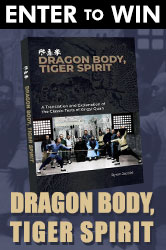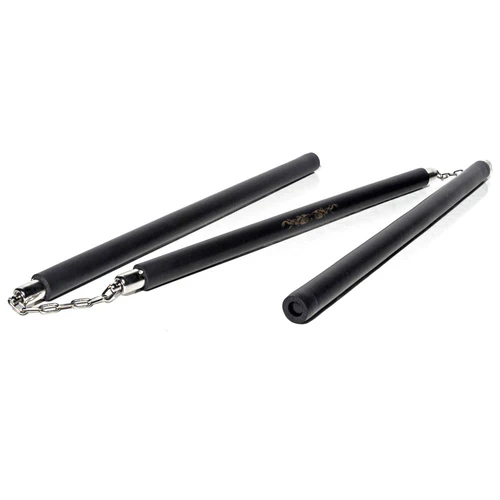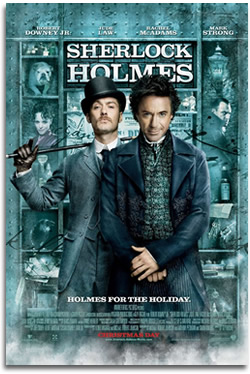 The last thing you might expect on Christmas Day is to see Sherlock Holmes step out of his gentlemanly, violin-playing cerebral calm to become a scruffy, filthy, addiction-addled martial arts madman. Then again, those of us familiar with Sherlock Holmes - as penned by Scotsman Sir Arthur Conan Doyle - know he was a habitual cocaine user as well as master of a mystical martial art (introduced in "The Adventure of the Empty House," first in a 13-story series (penned between 1903-1904) culminating in Holmes killing his arch nemesis Professor Moriarty by using a martial arts move to throw him over Reichenbach Falls).
The last thing you might expect on Christmas Day is to see Sherlock Holmes step out of his gentlemanly, violin-playing cerebral calm to become a scruffy, filthy, addiction-addled martial arts madman. Then again, those of us familiar with Sherlock Holmes - as penned by Scotsman Sir Arthur Conan Doyle - know he was a habitual cocaine user as well as master of a mystical martial art (introduced in "The Adventure of the Empty House," first in a 13-story series (penned between 1903-1904) culminating in Holmes killing his arch nemesis Professor Moriarty by using a martial arts move to throw him over Reichenbach Falls).
"Doyle called that martial art baritsu in the novels, which is tied to a 19th century hybrid of jujitsu that is actually called bartitsu, which was created by Edward William Barton-Wright," Robert Downey Jr. (who tackles the title role in SHERLOCK HOLMES) shares. "Jujitsu is Guy's (film's director Guy Ritchie) chosen martial art, and mine is wing chun kung fu. So, we developed our own combinations of martial arts styles for the movie.
"When you get down to it, Holmes was probably the first superhero, an intellectual superhero. He was, and probably still is, one of the most recognizable icons on Earth, so much so that a lot of people actually thought that Sherlock Holmes was a real person.
"The more you look into Arthur Conan Doyle's books, the more you see what a rich character Sherlock Holmes is. He's very adept at so many things: He plays violin;; he's a martial artist;; a boxer;; an expert single-stick fighter;; and a swordsman of sorts. He has a strong moral code in helping good guys catch bad guys, so he has dedicated his life to being a consulting detective. He doesn't do it to show everyone how smart he is, or that he has figured everything else out when they haven't; he's actually a crusader."
According to Ritchie, Sherlock Holmes - modeled after Conan Doyle's former boss (Dr. Joseph Bell) at the Edinburgh Royal Infirmary, embodies the gift of seeing beyond the obvious and discerning the truth from within the haze of deception. This was apparent from the beginning with A Study in Scarlet (published in 1887), the first of 56 stories and eventually four novels written by Conan Doyle. Holmes's best friend and flatmate, Dr. John H. Watson, assists Holmes in all 56 tales, and is depicted in all but four of the adventures as the narrator. Furthermore, the stories and novels were mostly set in England between 1875 and 1907, with Conan Doyle's last case being solved in 1914.
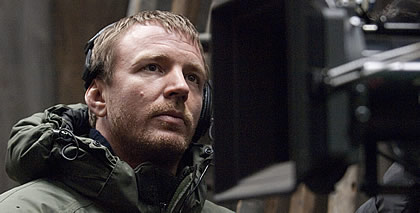
Ritchie, a fan of Holmes since childhood, wanted to delve deeper into Conan Doyle's works and peel back the layers on Holmes. "We've tried to take him back to what we believe to be his origin, which is essentially a more visceral character," Ritchie points out. "We've tried to integrate that and make him more streetwise. He is inquisitive about chemistry, martial arts, and the human condition. Yet he managed to percolate through all the different echelons of English society, which was tremendously complex. But then, as now, Sherlock Holmes is unique; there's really no one else like him. I think that's why his appeal has stuck. And while our story is rooted in London of the 1890s, we have tried to make it as contemporary as we possibly can."
Downey hinted at this contemporary mindset on Monday night's David Letterman show (Dec. 21) when he suggested that the relationship between Holmes and Watson might be less than platonic. Such a strategy actually hurt the success of Oliver Stone's ALEXANDER (2004), which alluded to the famed Macedonian warrior Alexander the Great being homosexual. Downey's slip of the tongue has studio execs concerned that it might prevent SHERLOCK HOLMES from becoming successful. The clues abound if you listen more carefully to the riddled words of the gypsy soothsayer who ruminates to Watson and Holmes in a desolate back street of London.
So what case are Holmes and Watson about to tackle? London 1890, Victorian England, when the London Tower Bridge was being built (not London Bridge, which is a different structure) and that black cloud hanging over London - partly soot and partly due to the dastardly psychosis of Jack the Ripper - is about to turn into a major storm, a threat unlike anything Holmes has ever confronted.
As the film opens, Lord Blackwood (Mark Strong) is about to perform the last of a series of ritualistic murders when Holmes and Watson (Jude Law) showcase their martial arts to save the latest victim and defeat the black magic arts master and unrepentant killer. As Blackwood's hanging draws near, he warns Holmes that death has no power over him. The execution plays right into Blackwood's plans, as he seemingly makes good on his promise. His apparent resurrection panics London and confounds Scotland Yard (so named because it was built on land owned by Scottish Kings).
Yet according to Holmes, "The game is afoot" (one of many classic lines that Conan Doyle coined for the character), and Holmes and Watson must now step into a world of dark arts and startling new technologies. Although logic is their best crime-fighting weapon, they never pass up an opportunity to apply their martial arts skills against the various goons and bad blokes out to stop them.
As efficient as Holmes's intellect is in neutralizing an enemy in the course of his investigations, in this film Holmes blows off steam in bare-knuckles bouts at a working-class pub called the Punch Bowl. In front of raucous crowds that bet against the lithe detective, he uses elbow strikes, kicks, distractive strategies and - yes - a wee bit of wing chun against giants of men.
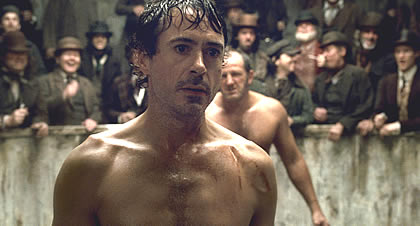
"The bare-knuckle boxing ring is the only place where Holmes doesn't think," says Downey. "But even there he does think; he thinks about how to win the fight, but doesn't think about all of these ongoing concerns of life. Interpersonal relations don't enter into it. It's just you and your opponent."
"The Punch Bowl is where Holmes goes to hone his skill, to make mistakes, and test out his techniques against very powerful opponents," comments fight consultant Eric
Oram. "He starts by using the least amount of force in the first half of the fight. It's only after his opponent crosses the line that he wants to teach him a lesson."
Oram has trained Downey for over six years in wing chun. They've done 10 films together, including IRON MAN, IRON MAN 2 and of course SHERLOCK HOLMES. In SHERLOCK HOLMES, Oram was largely responsible for choreographing Holmes's fights, served as Downey's fight double, and directed the bare-knuckle sequences between Downey and his Punch Bowl baddies. In actuality, the fights are supposed to demonstrate Holmes's deftness in baritsu rather than in boxing.
 Baritsu is a martial art created in 1898 by Edward William Barton-Wright, who was a British engineer living in Japan for three years during the Meiji Restoration (1868-1912 - a time after the fall of the Tokugawa Shogan when Emperor Meiji opened Japan's doors to Western science, technology and military weapons). Barton-Wright studied jujitsu, and upon his return to England presented his knowledge as a new self-defense system named partially after his Barton namesake and after jujitsu, thus "bartitsu," later shortened in the press to baritsu by way of a reporter's misspelling of the art. Apparently Conan Doyle was so enamored by this fighting art that he made Holmes a practitioner. However, the style's name might be misleading, as Barton-Wright also studied judo under that art's founder Jigoro Kano, and further incorprated into baritsu French foot fighting, English style boxing, the use of a coat as a self defense weapon, and La Canne - a "walking stick" fighting method created by famous Swiss fencer Pierre Vigny.
Baritsu is a martial art created in 1898 by Edward William Barton-Wright, who was a British engineer living in Japan for three years during the Meiji Restoration (1868-1912 - a time after the fall of the Tokugawa Shogan when Emperor Meiji opened Japan's doors to Western science, technology and military weapons). Barton-Wright studied jujitsu, and upon his return to England presented his knowledge as a new self-defense system named partially after his Barton namesake and after jujitsu, thus "bartitsu," later shortened in the press to baritsu by way of a reporter's misspelling of the art. Apparently Conan Doyle was so enamored by this fighting art that he made Holmes a practitioner. However, the style's name might be misleading, as Barton-Wright also studied judo under that art's founder Jigoro Kano, and further incorprated into baritsu French foot fighting, English style boxing, the use of a coat as a self defense weapon, and La Canne - a "walking stick" fighting method created by famous Swiss fencer Pierre Vigny.
Downey continues, "On the other hand, Watson's fighting is more about street combat, where he's more of a brawler compared to the fluid combat style of Holmes. Watson is used to the up-close-and-personal fight-for-your-life stuff. He has a much more accessible but no less effective style than Holmes. As a matter of fact, there are often times when Holmes over-thinks in order to come up with the best deduction, like in the opening fight and in the Punch Bowl brawls, where Watson will just strike with any tool that's handy."
Ritchie also used these sequences to deconstruct Holmes's thinking over the course of a fight, where besides going through the fight in his mind before Holmes ended the bout, Ritchie would accomplish this moment-by-moment technique using a high-speed digital camera called the Phantom, which creates an ultra-slow motion effect. "The Phantom takes one second of filming and strings it out over 40 or 50 seconds," Ritchie explains. "The camera takes in a great deal of information in a very short period of time, which is the perfect lens through which to illustrate how Holmes's mind operates. He is able to condense an enormous amount of information into a fraction of a second."

Though visually cool and a novel approach to choreography, to actually plan your fight and techniques beforehand is not always a good idea. As Bruce Lee said in film and TV, "Don't think, feel," and, "If you plan to bite someone during a fight, that is a very good way to lose your teeth." Also of note, the final visual look of the Phantom camera effect looks a lot like the camera work used by Sonny Chiba in his 1973 film KARATE WARRIORS.
For another key action sequence - taking place on a multi-story set representing the half-constructed London Tower Bridge - Ritchie rehearsed extensively with the actors, along with Oram and fight coordinator Richard R. Ryan. Ritchie sought a strategic blend of rehearsal and spontaneity to ensure the chaos of fighting was reflected in the sequences. "I made the creative decision to make the film gritty, so I didn't want things to be too choreographed," Ritchie explains. "We discussed everything, but we also made sure to leave room for improvisation. I didn't want it to look too perfect."
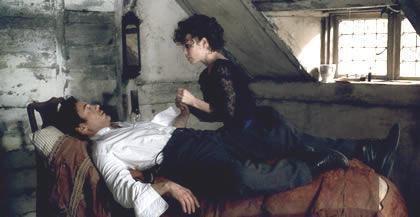
Ironically, Ritchie got was he was searching for. The fights don't look perfect; in fact, they were shot in typical Hollywood fashion with tight shots, MTV-style editing and loud sound effects, all of which tends to hide what could have been some very creative and interesting fights. And while the film's trailer was intriguing me and raised my expectations, the final result falls short.
Although the look of the film captures the grittiness of 1890 London, Downey's new-fangled portrayal of Holmes may have been inspired by the creative license Heath Ledger took with his Joker character in THE DARK KNIGHT (2008). Not that Downey acts like Ledger, but he tries to instill a novel persona into a traditional, Victorian-English Holmes. Thus, gone is Holmes's patented deerstalker cap, Inverness cape and his sink-plumbing-shaped smoking pipe. Also missing is Holmes's signature quote, "Elementary, my dear Watson." I'm not sure if these things will fly well with staunch Holmes fans. Personally, compared to the cool, suave, well-acted portrayal of Holmes by Jeremy Brett (the best Holmes ever; Basil Rathbone being the second best), Downey's rendition of the Holmes character (scruffy, messy, jealous of Watson getting married, and overall brazen in his detective work) seems to strain to be different, which could doom the film for staunch Holmes fans.
The foundation of Holmes's calm demeanor is rooted and hidden in Conan Doyle's interest in the mysticism of India, specifically the meditative sound "ohm." The Cockney accent of East London would pronounce "Holmes" without the "H," thereby calling the centered detective "Olmes." So Merry Christmas to all, and to all a good night.
About
Dr. Craig Reid :
![]() Written by Dr. Craig Reid for KUNGFUMAGAZINE.COM
Written by Dr. Craig Reid for KUNGFUMAGAZINE.COM
![]() Print Friendly Version of This Article
Print Friendly Version of This Article
